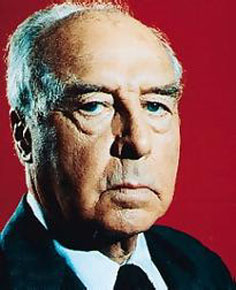John Houseman (born Jacques Haussmann, September 22, 1902 – October 31, 1988) was a Romanian-born British-American actor and film producer. Academy Award-winning actor John Houseman's main contribution to American culture was not his own performances on film but rather, his role as a midwife to one of the greatest actor-directors-cinematic geniuses his adopted country ever produced (Orson Welles) and as a midwife to a whole generation of actors as head of the Julliard School.
Houseman was born in Bucharest, Romania in 1902, the son of a British mother of Welsh and Irish descent and a Jewish father of Romanian ancestry who ran a grain business. He was educated in England at Clifton College, became a British citizen and worked in the grain trade in London before emigrating to the United States in 1925, where he took the stage name of John Houseman. He became an American citizen in 1943.
He directed "Four Saints in Three Acts" for the theater in 1934. Houseman joined with Orson Welles (whom he affectionately called "The Dog-Faced Boy") in 1937 to mount startling productions of the classics in their avant-garde
Mercury Theater. Their most important success was a modern-dress version of Shakespeare's "Julius Caesar," in which the spectre of Hitler and Mussolini's Fascist states were evoked. The
Mercury Theatre on the Air subsequently became famous for its notorious 1938 radio adaptation of H. G. Wells' The War of the Worlds, which had put much of the country in a panic.
As a producer assigned to
Unit 891 of the Federal Theater Project funded by the government's Works Progress Administration, he produced the legendary production "Cradle Will Rock," a musical about the tyranny of capitalism. On Broadway, apart from the
Mercury Theatre and the
WPA, Houseman directed "The Devil and Daniel Webster" (1939) and "Liberty Jones" and produced "Native Son" (1941). During World War Two, Houseman went to work for the Office of War Information and was involved in broadcasting radio propaganda for the Voice of America. After the war, Houseman returned to directing and produced Metro-Goldwyn-Mayer's 1953 version of Julius Caesar (1953).
Toward what looked like the end of a long career, when he was 66 years old, Mr. Houseman helped establish the school of drama at the Juilliard School and also became the co-founder and longtime artistic director of the Acting Company, the touring repertory group whose alumni include Kevin Kline and Patti LuPone. He resigned as artistic director last summer.
He helped establish the acting program at New York's famous Julliard School for the Arts, where he influenced a new generation of actors. Ironically, he had appeared in only one major movie, in a supporting role, before being tapped to replace James Mason in The Paper Chase (1973). He won an Oscar for the role and began a 15-year career as a highly sought after supporting player (Three Days of the Condor, Rollerball, The Cheap Detective, Ghost Story, My Bodyguard, Naked Gun, Winds of War, Noble House, and many others). Houseman, who wrote three volumes of memoirs,
Run-Through (1972),
Front and Center (1979) and
Final Dress (1983), died in 1988 after making major contributions to the theater and film.




















